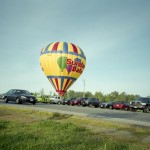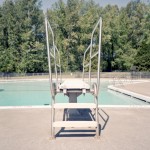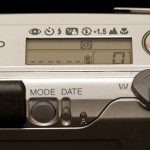Apr
3
2013

My first Canon camera was an AE-1 program which was a good camera but I was more partial to my Minolta gear at the time so never really warmed to it. So while the T70 isn’t an AE-1 program (I do realize that) I thought I would give a manual focus Canon SLR another try. Once again though a quick use of the camera doesn’t seem to be enough to come to terms with it. Yes it produced the results I was after but it’s controls or lack of them get in the way. I don’t mind automatic exposure and metering but I prefer an intuitive way of over-riding it. This camera is clearly designed to be used as a point and shoot SLR and is geared towards being left in a program mode. As I have a few Canon FD lenses that I want to try I may just hold out for a T90 or F1n or maybe something older, I don’t mind doing my own metering if needed.
So just what is so bad about adjusting this camera? It has 3 program modes that you cycle through before even getting to Shutter priority and it’s then that you have to take the lens off the A setting to get to manual if you want to adjust the exposure from the program line. The small buttons on the top also require taking the camera from your eye and looking down at them to make any adjustments, it just isn’t very photographer friendly. I do like that it takes only two AA batteries to operate though.
The film I used was an out of date roll of Kodak 400 Black and White for C41 (It uses the same chemistry as colour film but the negatives are monochromatic)
2 comments | posted in Cameras, Photography, Uncategorized
Mar
29
2013
These are all shot with older M42 mount Pentax Takumar lenses on my Pentax K-7 DSLR. They are actually easy to use when you restrict yourself to only using this one type. They thread on and off easy enough and you can leave the camera in manual focus mode which provides focus confirmation for the central focus point. Perhaps it’s because I grew up with manual focus cameras but it mystifies me somewhat why people obsess over how many focus points a cameras autofocus system has, are they just pointing the camera at a scene and letting the camera decide what’s important? It’s also necessary to leave the lenses in the manual aperture settings but metering is done with a quick press of the green button on the camera which is common to all Pentax DSLRs and the Q.

The lenses here consisted of the 28mm 3.5 Takumar, 35mm f2.3, 50mm f1.4, 200mm f4 and the 300mm f4. The real standouts though are the 50mm f1.4 and the 200 f4. The 35mm is actually pretty bad and could be used as a soft focus lens as seen here.

2 comments
Mar
25
2013
If you have visited my blog before you may know I like to shoot film. I like the look I get and I enjoy the chance to use all the different old cameras that are available. On this day I decided to take the Pentax Spotmatic II with a selection of Takumar lenses. The added benefit was that with an adapter these lenses fit on my Pentax K-7 DSLR as well. Despite the lens sharing weight savings between the two cameras the total weight in my camera backpack was significant, making me a bit top-heavy. I wasn’t alone but fellow photographer Duncan Turner had his gear more evenly distributed on his bike. Yes we rode bikes, what a great way to get around when taking pictures. You can cover more ground than when walking yet you are still able to see as much or more around you. Here are some selected images from the first of two rolls I shot through the Spotmatic.
3 comments | posted in Cameras, Photography, Uncategorized
Mar
23
2013

Hello 1983, keep the hair we will keep the cameras. Nikon refers to this camera as the “Pikaichi” which apparently translates as “Top notch” and they were quite proud of it. The lens is unique in that it has a focal length of 35mm yet is a Sonnar design which is more commonly associated with 50mm and above.

It seems to be a pretty good performing lens, unfortunately I used the Cherry wide angle and telephoto adapters on most of the pictures so the true performance is somewhat obscured.  The nice thing about this adapter set though is that they come with lenses for the viewfinder so you get the proper field of view but putting them on and taking them off is cumbersome. So what I like about this camera is the little focus distance scale in the reasonably large viewfinder and the feel of the camera. While not a light camera it fits nicely in one hand with its front grip and textured pad for your thumb. See the early 1980’s weren’t all bad.
The nice thing about this adapter set though is that they come with lenses for the viewfinder so you get the proper field of view but putting them on and taking them off is cumbersome. So what I like about this camera is the little focus distance scale in the reasonably large viewfinder and the feel of the camera. While not a light camera it fits nicely in one hand with its front grip and textured pad for your thumb. See the early 1980’s weren’t all bad.
4 comments | tags: camera, Nikon | posted in Cameras, Photography, Uncategorized
Mar
14
2013
Pictures from February 2013 with my Yashica Electro GT. More information about his camera can be found on my blog here Yashica Electro GT and here Yashica Electro GT and some more pictures here Images. What can I say I like this camera and keep coming back to it.
1 comment
Jan
21
2013

The Konica Big Mini is a camera that on first look might be easy to dismiss. It has a boxy appearance and seems just slightly larger than it needs to be. But it also a camera that just works. There is no fiddling or wondering or setting there is just pointing and shooting. This is of course the appeal of cameras of this type with the added benefit that this camera actually does allow adjustments like exposure compensation of +- 1.5 EV. There is a bit of vignetting but that is part of the look from the camera and is not objectionable. There is more information and images from the camera here Konica Big Mini including frustratingly a number of oxymorons that I wrote, but I’m not sure that I’m finding them all anymore.
1 comment
Nov
5
2012


I’ve been thinking about how to demonstrate the difference between these two 3d “cameras” but it’s not really possible in this 2d format. So it comes down to words I guess. Starting with the screens , despite the fact that both units display a 3d image without the need of glasses the Fuji screen is far superior. The 3.5″ Fuji screen has 1.15Mpixels doubling the HTC’s 4.3″ touchscreen with 540 x 960 resolution. The images displayed on the Fuji are clearer and more colourful. The difference continues with the lenses and sensors, The Fuji has two 10Mpixel 1/2.3″ CCD behind 3x zoom lenses that provides 35mm equivalent focal lengths of 35 to 105mm. The HTC lens and sensor are a bit of a mystery to me but they are a pair of 5Mpixel units and that is halved again when shooting 3D. The fact is it isn’t much of a contest, the Fuji is better all around but then it doesn’t make phone calls or post to Instagram. The surprise reaction of people who see the 3d image suggests to me that it is still a bit of a gimmick, this is also true because of the difficulty of doing anything with the 3d image. I don’t own any other device to display 3d images so they really are only of interest on the camera itself for now. In a sense when I’m taking 3d pictures I’m hedging that they will be of greater interest in the future. This is almost a truism of all photography as they represent a moment in time that won’t be repeated. I’m just doing it in an extra dimension.


The first image is down-sampled from the 7Mpixel Fuji file and the second from the HTC’s 2Mpixel file. At full resolution the difference is much more apparent.


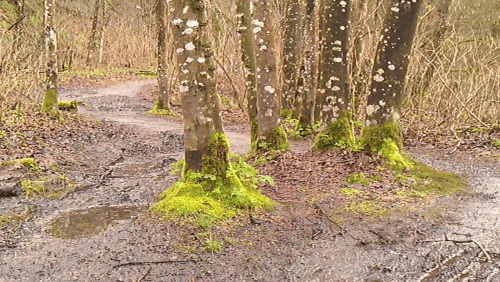

This mix of samples from the two “cameras” are being displayed as animated GIF’s or wigglegrams. The two images are toggling back and forth giving a view as if you stopped time and moved your head from side to side, you can stop time can’t you?
1 comment | tags: 3D, Cameras, Digital, Fuji, HTC | posted in Cameras, Photography, Processing, Uncategorized
Oct
12
2012

The Ricoh RZ3000 may be the best form factor for a film zoom point and shoot camera. While it is a larger than the Canon 180u or any of the Olympus Stylus cameras, it feels good in the hand. It has a nice grip on the right side that makes carrying it in your hand easy. The other reason is the top plate dials for changing modes, most of the other cameras like this have small rubber buttons that are hard to press accurately and only provide feedback via an LCD. With the dials the available exposure modes can be easily set and the large flash control button is separate and distinct. Another nice feature of the dials is the selected mode is illuminated with a pleasing glow making it easy to know how the camera is set when in dim light.
The lens is a 38 to 130mm f4.5 to 9.5 with aspherical elements (6 elements in 3 groups)
Ricoh describes the auto-focus as having 7 zones with 1024 steps. The camera also has an infinity mode selected via the top dial and a single center focus point mode. Other modes are portrait where the camera sets the flash to fire for fill and sets single focus point automatically. The zoom also automatically changes to frame the person with a half press of the shutter. Action mode sets auto-focus to single point and the drive mode to continuous.
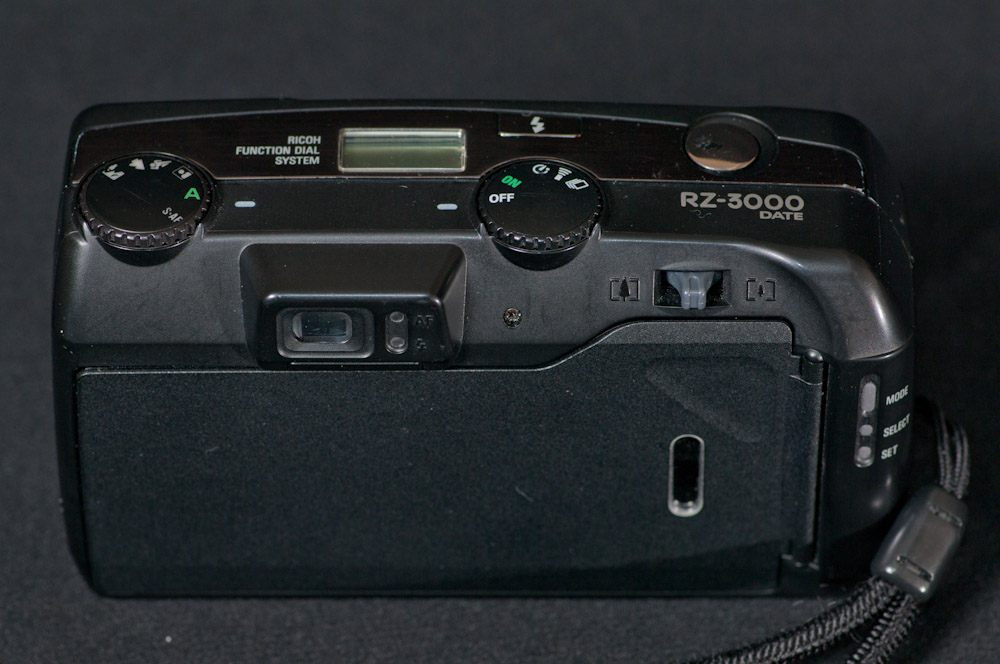
The major detraction is the lack of any exposure overrides, all exposure is handled by the camera. I have only run one roll of film through the camera and it was some very poor Polaroid 400 that was at least 10 years out of date. The point was to test that it worked before committing to using good film that is becoming even more precious.
I’m intrigued enough with this camera to give it another try with better film. Until then here are some sample images from that initial roll.
8 comments
Aug
23
2012
Today Kodak announced they intend to sell off there film business as part of the plan to emerge from Chapter 11 bankruptcy protection. What most people think of when they think Kodak, “film” is tucked away under Paper and output systems, which is going up for sale. I wish I could say I’m optimistic about still image film continuing to be produced but any company that takes this on would have to make a profit and film has really become a niche market (excluding motion picture film)
Momma don’t take my Kodachrome Ektachrome Ektar away.
no comments
Jun
21
2012
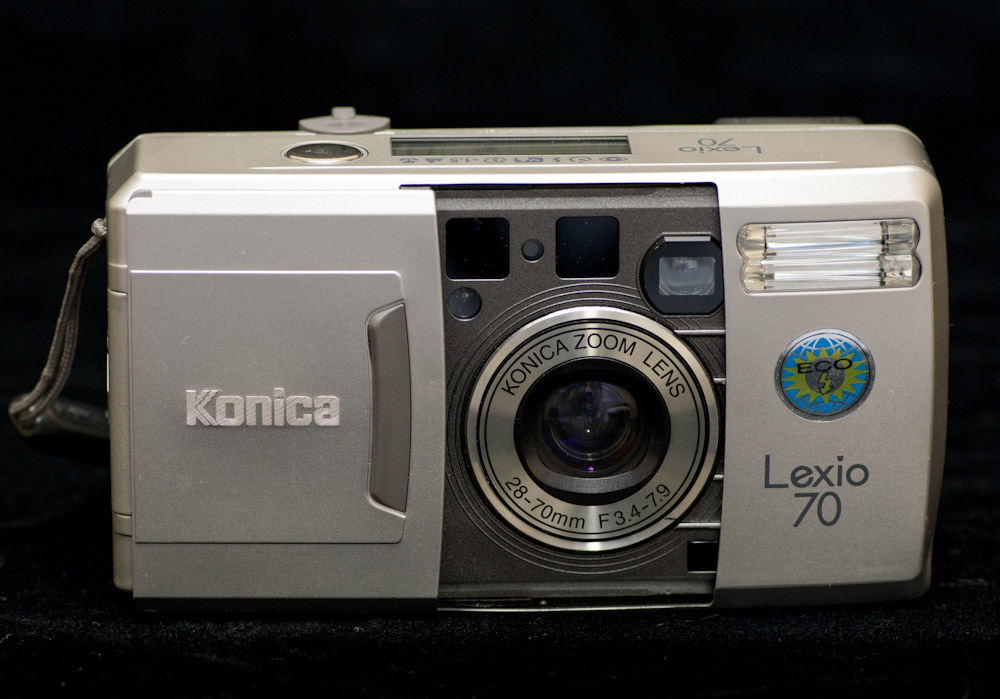
The Konica Lexio 70 was introduced in 2000 and thankfully wasn’t the hope for the new millennium because despite having good specifications on paper it’s let down by a lens that creates images unsafe for viewing. Perhaps not quite that bad but I would include this camera in the Lo-Fi category along with plastic lens cameras just because of the distortion and ugly bokeh
A weird thing about the Konica Lexio 70 is that when it focuses the viewfinder framing changes with the lens focus movement, I can’t tell if the image is captured with the new framing after this change of view. Also a design fault with this camera is the lens cover on/off switch. It performs it’s on off function at the most inopportune time with the slightest movement of the lens cover.
You can see in the following image that the bokeh is horrible, as this is the only Lexio 70 I have to test I don’t want to make any presumptions but I will, I doubt it gets much better. It also has some weird pincushion distortion at the wide end that isn’t even across the frame. I found another persons set on Flickr had the same distortion so I believe it’s a characteristic of the camera. This appears most obviously with straight lines that become stretched upwards towards the edges. This may be caused by the aspherical elements in the lens and is much more dramatic than with a simpler lens design.

What I do like about it is that although it resets to full auto after powering off and on it does remember the last setting you had selected so that when you press the mode button it jumps to that one, which can be any of the eight over rides it provides.

As it affords a 28mm focal length at the wide end, which is somewhat rare in a point and shoot, it’s worth picking one out of the thrift store pile for a couple dollars. That is as long as you know the limitations.
1 comment | tags: camera, film, Konica | posted in Cameras, Photography, Uncategorized
















































































































